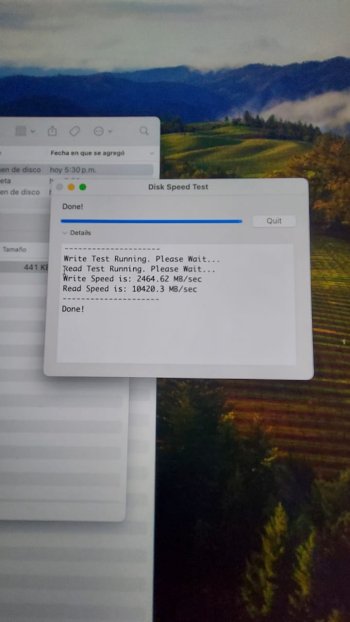SSD upgrade by Terraaustralis
15/8/2023
Device: iMac 5K 27" 2019 - 19.1 - 3.7GHz i5-9600 6 core MRR12LL/A, EMC3194, A2115.
NVMe upgrade: 256GB Apple > 2TB WD Black SN770
Speed test: 2960 MB/s read, 2824 MB/s write Blackmagic
SATA upgrade: HDD > 2TB Samsung Evo 870 SSD
OS: Monterey then Ventura 13.6.3
FileSystem: APFS,
Boot Rom Version: 2020.40.3.0.0
Boot Time: Total system/data 1.2TB: 28 seconds.
Black Magic: Previous Fusion speed 700MB/s: Upgraded NVMe speed, Write 2783MB/s
, Read 2983MB/s
Location: Australia
Issues after fresh OS install: See below.
Background:
I have no IT background but as an artist/craftsman am useful with my hands. I did successfully, upgrade the CPU of an Apple G4 last century, but I would never have embarked upon this exercise without having such detailed information available from the many Guru’s who contribute to this site.
I thank you all heartily and with great sincerity. Apple charges AUD$1500 for a 2 TB NVMe SSD. The open market offers a 2TB SSD for AUD$200.
Why would I not consider rising to the challenge of personally upgrading my iMac?
Technique:
1. Deciding on a suitable model NVMe was difficult. As a Samsung advocate, I tested the 980 Evo Pro against the WD Black SN770 and found the WD Black worked best. Articles on
https://www.tonymacx86.com/threads/...or-your-macos-boot-drive.323479/#post-2350166 confirmed over time, the Samsung would accumulate problems as an internal boot drive and WD Black was recommended.
2. Although I tried the wheel, I chose to remove screen by slicing through the double-sided tape with a scalpel. Less strain on glass, but one must be very careful to tilt blade cutting edge away from glass otherwise black paint can be scratched off the glass. The blade should not be inserted more than 3-4mm deep. On the 2019 iMac, unlike other models, there are no cables projecting beyond the aluminium frame. Nevertheless, I was cautious in the camera area.
3. Stripping tape off using Isopropyl Alcohol is also a challenge. It is difficult to clean off all residue at the ‘chin’ - bottom, of the frame. Too much rubbing on the back margin of the screen can also remove the black paint.
I re-painted with Acrylic hobby paint.
4. Experience has taught me to respect static electricity and I now always wear surgical gloves. Wrist cables are something of an obstacle. I vividly remember opening a 2007 imac to replace HDD with SSD. On re-assemby there was no power.
I absolutely had not touched the power unit. Although I wore a wrist cable, my studio floor is carpeted and the wrist clip was earthed to the aluminium iMac. Aluminium is a poor electrical conductor. I believe static must have jumped from me to the power unit. Now I never understimate the power of static electricity.
Problem 1:
On first re-assemby of iMac, screen was black. LED pilot lights showed 123&5 green and so I suspected a LCD cable or cable connector problem. I purchased a new LCD cable. Screen still black on re-start. Finally I took the iMac to a micro-soldering specialist who, two days and AUD$300 later, found the weak component on the logic board and replaced it. I was happy to have the problem resolved at relatively little cost.
5. As a precaution against any future failure, I decided to keep the screen sellotaped on for six months before considering the application of Apple tape.
Update 30/11/2023
Problem 2.
After three months of perfect operation, I booted into to a kernal panic. Absolutely no change in set up. But there it was! I was unable to boot into verbose mode or access any logs. I decided to replace SN770 NVMe with the original Apple blade. Advice from
trs96, a moderator at tonymacx86 was that the Sintech adater is incompatible with the SN770, See:
https://www.amazon.com/dp/B01CWWAENG?psc=1&ref=ppx_yo2ov_dt_b_product_details&tag=mrforums-20.
Sintech is apparently not compatible for WD SN770 amongst several other NVMe SSD’s.
I have now replaced the Sintech adapter with a No-Name short adapter from AliExpress and reinstalled the SN770 as boot drive with Ventura 13.6.3. Restart is flawless and operating properly so far. I now hope the NVMe/adapter combination will pass the six month operations time test!
Would I have embarked upon this task knowing the potential for problems? Yes. I enjoy problem solving, it is essential to my business, and learned practical knowledge is an asset. I did spend more than I anticipated (1 x 2TB SN770 + 1 x 1TB Adata external, 1 x SATA Samsung SSD and adapters cables, tape etc - about AUD$700, plus repair AUD$300). I now have a
4 x faster and 4 x larger capacity machine and the confidence to fix problems arising.
Postscript:
Some readers posted comments to the effect that upgrading is easier by purchasing an external 4TB TB3 SSD unit and booting from it. In retrospect that may be so. But I hate desk clutter and already have 4 back-up drives etc. which take up too much space as it is. Upgrading internals may be more work - and risk, but the resulting boot speed and operational performance makes it all worthwhile for me and I keep my desk clear for creating art/craft work.






